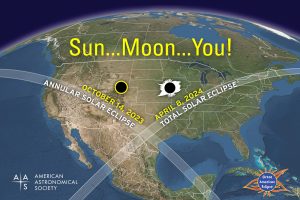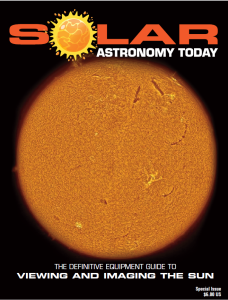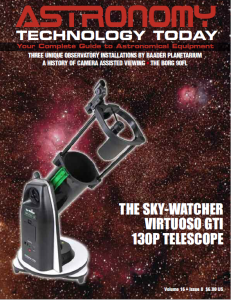In 2014 the American Astronomical Society (AAS) created the AAS Solar Eclipse Task Force to help coordinate national preparations for the “Great American Eclipse” of August 21, 2017. The task force, meant to function as a think tank, coordinating body, and communication gateway/hub, was composed of professional and amateur astronomers, formal and informal educators, eclipse chasers, science writers, and outreach specialists. The charter of the AAS Solar Eclipse Task Force has been renewed through 2024.
 Created with the support of funding from the National Science Foundation (NSF), NASA, and the AAS, the task has carried out three main activities: (1) Offer a website with basic information about solar eclipses, safe viewing practices, and eclipse imaging and video, along with resources for educators and the media; (2) managed a mini-grants program to support eclipse-related education and public outreach to underrepresented groups; and (3) organized a series of multidisciplinary workshops to prepare communities for the eclipse and to facilitate collaboration between astronomers, meteorologists, school administrators, and transportation and emergency-management professionals. The safety advice was developed in collaboration with eye doctors was widely endorsed, and the efforts to keep the public safe during the 2017 eclipse were successful.
Created with the support of funding from the National Science Foundation (NSF), NASA, and the AAS, the task has carried out three main activities: (1) Offer a website with basic information about solar eclipses, safe viewing practices, and eclipse imaging and video, along with resources for educators and the media; (2) managed a mini-grants program to support eclipse-related education and public outreach to underrepresented groups; and (3) organized a series of multidisciplinary workshops to prepare communities for the eclipse and to facilitate collaboration between astronomers, meteorologists, school administrators, and transportation and emergency-management professionals. The safety advice was developed in collaboration with eye doctors was widely endorsed, and the efforts to keep the public safe during the 2017 eclipse were successful.
By continuing its activities the AAS Solar Eclipse Task Force will help prepare citizens of, and visitors to, the U.S., Canada, and Mexico to safely experience and enjoy the upcoming two major solar eclipses coming to North America. On October 14, 2023, an annular (“ring”) eclipse sweeps from Oregon to Texas and then on to Central and South America. Just six months later, on April 8, 2024, a total solar eclipse darkens a swath across Mexico, from Texas to Maine, and then on to the Canadian Maritimes. In both cases virtually all of North America will have at least a partial solar eclipse.
Among the updated AAS Solar Eclipse Task Force responsibilities include the following in 2023 and 2024.
– Identify and involve appropriate astronomy- and eclipse-related organizations, groups, and individuals, and coordinate their efforts to maximize reach/impact and minimize redundancy.
– Collect existing ideas and generate new ones for eclipse-related education, public outreach, and public engagement, as well as for eclipse-related citizen-science projects.
– Support/encourage frequent and effective communication and idea sharing among stakeholders.
– Support/encourage the creation and widespread distribution of good/reliable information about partial, annular, and total solar eclipses, especially how to experience and record them safely.
– Support/encourage the creation and widespread distribution of good/reliable information about weather prospects, eclipse circumstances, logistics, and other factors relevant to choosing a site from which to view an eclipse.
– Support/encourage the debunking and quashing of bad/unreliable (mis)information.
– Work with solar-filter manufacturers, resellers, and online marketplaces to ensure that the public has access to eclipse viewers that meet ISO standards and to instructions for their safe use, and to thwart the sale of filters that do not meet such standards, as occurred in 2017.
– Enlist the cooperation and assistance/support of the medical and optometric communities.
– Enlist the cooperation and assistance of the media and broadcast meteorologists, formal and informal educators, artists, musicians, and other messengers/communicators.
– Enlist the cooperation and assistance of local, state, and federal government officials as well as school administrators and transportation and emergency-management professionals.
– Enlist the cooperation and assistance of the corporate sector, including (but not limited to) astronomy-related businesses and industries.
– Encourage as many people as possible to get themselves into the path of annularity on October 14, 2023, and/or into the path of totality on April 8, 2024.
To learn more about the AAS Solar Eclipse Task Force efforts and how to get involved visit their website at www.eclipse.aas.org.

 The sun is more active than its been in years! If you’d like to learn more about the technology behind solar observing, solar imaging and more, you can check out our free publication, “The Definitive Guide to Viewing and Imaging the Sun”. You don’t have to sign up or provide any information, simply click here and enjoy reading!
The sun is more active than its been in years! If you’d like to learn more about the technology behind solar observing, solar imaging and more, you can check out our free publication, “The Definitive Guide to Viewing and Imaging the Sun”. You don’t have to sign up or provide any information, simply click here and enjoy reading!
And if you want to learn more about telescopes and more products used in amateur astronomy you will enjoy the extensive news, articles and reviews that are only available in the magazine pages of Astronomy Technology Today. We are offering a 1-year magazine subscription for only $6! Or, for an even better deal, we are offering 2 years for only $9. Click here to get these deals which only will be available for a very limited time. You can also check out a free sample issue here.

